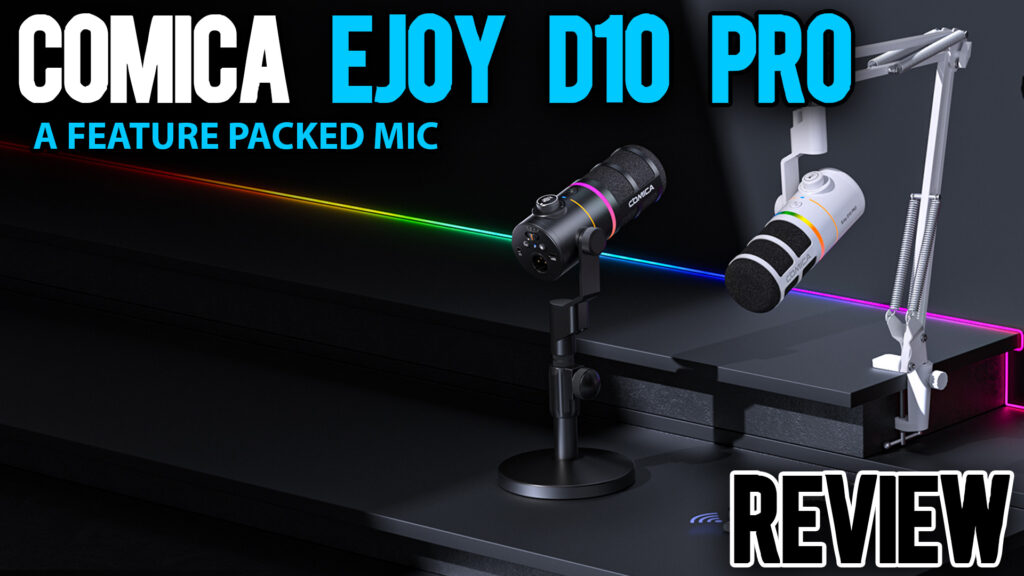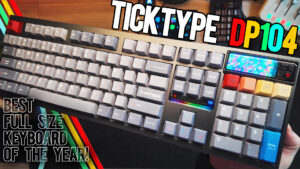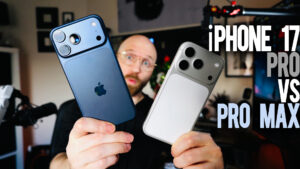🎙️ Comica Ejoy D10 Pro Review: Budget Mic with Studio Ambitions

When it comes to microphones under $100, expectations are often low—tinny sound, unreliable connections, poor build quality. But every once in a while, a mic breaks the mold. Enter the Comica Ejoy D10 Pro—a dynamic cardioid microphone that not only tries to punch above its weight class but actually lands a few clean hits.
At $92, this mic isn’t just competing with the budget tier—it’s flirting with the prosumer space, offering XLR, USB-C, and wireless dongle connectivity, built-in EQ, real-time monitoring, and even RGB lighting. Whether you’re a content creator on a budget or just dipping your toes into the podcasting or streaming world, this is a mic that demands attention.
🔧 Tech Specs & Build Quality
- Type: Dynamic cardioid microphone
- Connectivity: XLR, USB-C, Wireless Dongle
- EQ Modes:
- 🔶 Orange – Bass Boost
- 🔵 Blue – Natural
- 🟢 Green – Treble Boost
- Noise Cancellation: On-board toggleable
- RGB Lighting: Multiple color and animation modes
- Monitoring: 3.5mm headphone passthrough
- Stand: Metal base, height adjustable, heavy and stable
Visually, the D10 Pro bears a resemblance to the iconic Shure SM7B, with a matte-black body and rounded grille. But don’t mistake this as just a clone—the Comica puts its own spin on utility by including an RGB touch panel, USB-C port, and a detachable foam windscreen.
The included stand is heavy and stable, something you rarely find at this price point. It’s adjustable, and the mic itself is built to be held, mounted, or table-top ready—depending on your podcasting or gaming setup.
🔌 Modes in Action: XLR vs USB vs Wireless
🎚️ XLR Mode: Premium Sound
Plugged into a proper mixer, the D10 Pro transforms. Gone is the slight compression from its digital modes. You get a rich, detailed, and unprocessed sound profile—easily rivaling microphones in the $150–$200 range. It’s here where the mic shines and shows what its dynamic capsule can really do.
Important note: In XLR mode, the onboard EQ and noise cancellation do not function. It’s a raw, analog connection—which is great if you want full control from your mixer or DAW.
🔌 USB-C Mode: Plug-and-Play Simplicity
In USB mode, the mic shows off its real selling point: ease of use. This mode activates the touch EQ panel, where you can switch between bass-boost, natural, or bright treble-heavy profiles. You’ll also be able to enable real-time monitoring via the headphone jack and toggle noise cancellation with a long press.
For streamers and podcasters without expensive gear, this mode is more than passable—it’s actually quite good. While it doesn’t match the richness of XLR, it’s clear, decently full-bodied, and easy to dial in.
📶 Wireless Mode (with USB-C Dongle)
Using the included wireless dongle, you can connect the mic directly to a smartphone, tablet, or laptop via USB-C. This turns the D10 Pro into a mobile recording powerhouse.
We tested this near a fan to simulate real-world conditions, and while the noise cancellation helped, the compression was definitely noticeable. You’re trading a little sound quality for true convenience, but the mic is still more than usable for mobile creators and vloggers.
🎛️ Built-in EQ & Noise Cancellation
The mic features 3 EQ presets, all selectable through a touch panel:
- Orange: Boosts low-end for a bassy, broadcast-like tone.
- Blue: Neutral and natural, ideal for most voices.
- Green: Brighter top-end for clarity, especially in noisy rooms.
These EQ settings only work in USB or wireless modes, not XLR.
Noise cancellation is effective at reducing low-level fan or background hum, though it can also affect voice clarity slightly. It’s ideal for casual use, but professionals may prefer to handle noise in post-processing instead.
💡 Extra Features: RGB & Monitoring
Let’s be real: RGB on a mic is usually just for aesthetics. But the Comica D10 Pro makes it functional, offering:
- Solid, breathing, or rainbow RGB modes
- Touch-to-toggle design
- Visual indicator of EQ and noise cancel states
You also get zero-latency headphone monitoring—a must-have for podcasters or streamers who need to hear themselves live. This works beautifully in USB and wireless modes.
🧪 Live Use Testing: From Boom to Bedroom
In testing:
- XLR mode was best for voiceovers, podcasting, or studio setups.
- USB mode was perfect for Twitch, Zoom, or quick content creation.
- Wireless mode was great for mobile creators, though slightly processed.
Holding the mic (Gen Z-style) does introduce handling noise, but mounted properly, it’s dead quiet. The foam pop filter does an okay job—though plosives could still sneak through depending on your mic technique.
✅ Pros
- Surprisingly good sound quality—especially via XLR
- Three connection types make it ultra-versatile
- Built-in EQ and real-time monitoring
- Noise cancellation toggle helps in noisy environments
- Sturdy, adjustable metal stand included
- Great value for price
❌ Cons
- Wireless/USB modes are noticeably more processed
- No EQ/noise cancel features in XLR mode
- Handling noise is an issue when hand-held
- RGB is cool, but not necessary
- Noise cancellation is limited in loud environments
💬 Final Verdict
The Comica Ejoy D10 Pro is a surprising win in the world of sub-$100 microphones. While it’s not going to dethrone the RE20 or Shure SM7B, it offers multiple recording modes, solid sound quality, and real-world features that many mics at this price flat-out lack.
If you’re a beginner streamer, an on-the-go podcaster, or a content creator looking for flexibility, this mic is an easy recommendation. Plug it into an XLR interface, and it competes in a much higher tier.
🎧 Recommended For:
- Up-and-coming streamers
- Podcasters on a budget
- Mobile creators who need versatility
- Anyone not ready to drop $400 on a mic setup




